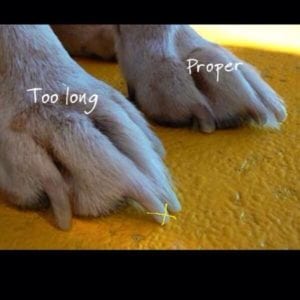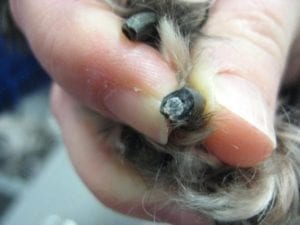Choosing between a dog and a cat can be tough. Typically,…
How Often Should We Trim Our Dog’s Nails?
Pet owners often wonder, “How often should I trim my dog’s nails?” and more importantly, “How?”
A number of factors can determine exactly how long is necessary between your pet’s nail trims.
Activity Level
- More active pets will naturally grind their nails as they walk, run, or play regardless of the location. Meaning less frequent nail trims for you
Exercise Surface
- Pets who are able to exercise on an abrasive surface such as concrete tend to experience less frequent nail trims. The concrete can act like an emery board and slowly shorten the nails day by day. Let the ground do the trimming for you!
Maintenance
- Keeping on top of your pet’s nails is important, but how can we tell if the nails are “too long”?
How short do we trim?
Examine this photo of a dog’s nails :
You will notice the tips of the nails are white. This area is comprised of non living tissue and will be painless for the dog to trim.
Just beyond that, we notice the pink color change. This area of the nail is living tissue and should not be included in the trim. Groomers refer to this “vein” as the “quick”.
The goal should be to trim the nails just to the quick (pink living tissue), with about 1/4 inch of non-living tissue remaining.
What happens if we cut into the “quick”?
- First, don’t panic. It may be painful for the dog, however not life threatening.
- Apply pressure to the cut nail to stop the bleeding.
- If the pet wont allow you to go near the sensitive and now bleeding nail. Confine the pet in a small space, such as a crate, with a towel laid down to stop the bleeding.
- Ideally the pet’s body weight will clot the area and stop the bleeding.
- Use a specialized clotting powder called “styptic powder” to stop the flow of blood
- In a pinch, flour or corn starch can be substituted for styptic powder.
Black Nails
If the pet has clear nails, it is quite easy to notice where the quick begins and ends. However many pets have black or pigmented nails, eliminating this option.
When trimming black dog nails it is important to find the pulp. As you cut, you’ll see a white color on the cut surface. This means you haven’t reached the pulp yet. The pulp is located just before the quick. It is dark in color but able to be identified by a circular appearance. At the pulp, is where we should stop on black nails.
Consult a Pet Professional
Nail trims can be as stress free as a walk in the park, or potentially nightmarish for the owner.
We understand that all pet’s may not have had good experiences with nail trims in the past, and all will react differently.
A pet professional will be able to determine if the nails are too long and has experience accommodating nervous or inexperienced pets.



